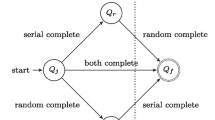Abstract
In this article, scan design for testability (DFT) methods are categorized based on the percentage of storage elements made scannable. The non-scan element state retention problem that occurs in partial scan design methods, in which not all of the storage elements are implemented as scan elements, is discussed. Solutions to this problem are described and the overheads associated with them are discussed. An economic model that allows the costs of a range of scan methods that differ in the percentage of storage elements made scannable to be compared with each other is presented. It is shown that, for systems produced in low volumes, the adoption of full scan DFT can be more cost-effective than partial scan DFT when life-cycle costs are considered if it results in significant reductions in the time taken to get the product to market.
Similar content being viewed by others
References
T. Gheewala, “CrossCheck: A Cell Based VLSI Testability Solution,” 26thACM/IEEE Design Automation Conference, pp. 706–709, 1989.
K.T. Cheng and V. Agrawal, “An Economical Scan Design for Sequential Logic Test Generation,”Proceedings of International Fault Tolerant Computing Symposium, pp. 28–35, 1989.
T. Williams and K. Parker, “Design for Testability — A Survey”,Proc. IEEE, vol. 71, pp. 98–112, Jan. 1983.
S. C. Seth and V. D. Agrawal, “Cutting Chip Testing Costs”,IEEE Spectrum, pp. 38–45, April 1985.
V. Chickermane and J. Patel, “An Optimization Based Approach to the Partial Scan Design Problem”,IEEE International Test Conference, pp. 377–386, 1990.
V. Chickermane and J. Patel, “A Fault Oriented Partial Scan Design Approach”,IEEE International Conference on Computer Aided Design, pp. 400–403, 1991.
R. Gupta et al., “The Ballast Methodology for Structured Partial Scan Design”,IEEE Trans. Computers, vol. C39-4, pp. 538–544, April 1990.
D.H. Lee and S.M. Reddy, “On Determining Scan Flip-Flops in Partial-Scan Designs”,IEEE International Conference on computer Aided Design, pp. 322–325, 1990.
J.Y. Jou and K.T. Cheng, “Timing Driven Partial Scan,IEEE International Conference on Computer Aided Design, pp. 404–407, 1991.
Logic Design Manual for ASICs, LSI Logic, September 1989.
P. Varma et al., “An Analysis of the Economics of Self-Test,IEEE International Test Conference, pp. 20–36, 1984.
T. Gheewala and K. Pierce, “Economics of ASIC Test Development”,Economics of Design and Test for Electronic Circuits and Systems, A.P. Ambler, M. Abadir, and S. Sastry (eds.), Ellis Horwood Ltd., 1992, pp. 39–51.
M. E. Levitt, “Economic and Productivity Considerations in ASIC Test and Design for Test”,IEEE Compcon, pp. 440–445, 1992.
B. Davis,The Economics of Automatic Testing, McGraw Hill, U.K., 1982.
D. Ong,Modern MOS Technology Processes, Devices & Design, McGraw-Hill, 1984, p. 342.
W. McClean (ed.),ASIC Outlook 1994, ICE, Arizona, 1993.
T. M. Carroll,Microeconomic Theory, Concepts and Applications, St. Martins Press, N.Y. 1983.
T.W. Williams and N.C. Brown, “Defect level as a Function of Fault Coverage,”IEEE Trans. Computers, vol. C-30 pp. 987–988, Dec. 1981.
G. Ganapathy and J. Abraham, “Selective Pseudo Scan—Combinational ATPG with Reduced Scan in a Full Custom RISC Microprocessor”,30th ACM/IEEE Design Automation Conference, pp. 550–555, 1993.
T.W. Williams, Bill Underwood, and M.R. Mercer, “The Interdependence Between Delay-Optimization of Synthesized Networks and Testing”, 28thACM/IEEE Design Automation Conference, pp. 87–92, 1991.
Author information
Authors and Affiliations
Rights and permissions
About this article
Cite this article
Varma, P., Gheewala, T. The economics of scan-path design for testability. J Electron Test 5, 179–193 (1994). https://doi.org/10.1007/BF00972078
Issue Date:
DOI: https://doi.org/10.1007/BF00972078




